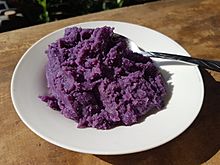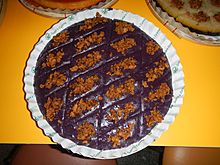Ube halaya facts for kids
 
Top: ube halaya is distinctively naturally purple
Bottom: ube halaya topped with latík |
|
| Alternative names | Ube jam, Halayang ube, Purple yam jam |
|---|---|
| Course | dessert |
| Place of origin | Philippines |
| Serving temperature | cold |
| Main ingredients | Mashed purple yam, coconut milk and/or condensed milk, and butter |
| Similar dishes | Taro purée |
Ube halaya is a yummy Filipino dessert. It's also called ube jam or purple yam jam. This sweet treat is made from a special purple vegetable called ube (pronounced OO-beh). Ube halaya is often used to make other delicious things like ube ice cream and pastries. You can also find it mixed into desserts like halo-halo.
Contents
The History of Ube Halaya
Ube is a very old plant in the Philippines. Scientists believe that ube plants were first grown and used by people in the Philippines and New Guinea. This happened a very long time ago. Pieces of ube have been found in an old cave in Palawan, Philippines. These pieces are about 11,000 years old! This shows how important ube has been to the people of the Philippines for many centuries.
How to Make Ube Halaya
Making ube halaya is a fun process. It starts with the main ingredient: the purple yam itself.
Gathering Ingredients
You will need peeled and boiled purple yam. This yam is then grated and mashed until it is smooth. Other key ingredients include condensed milk (which used to be sweetened coconut milk) and butter or margarine.
Cooking the Mixture
First, the butter or margarine is melted in a saucepan. Then, the mashed yam and condensed milk are added to the pan. The mixture is stirred continuously. You need to keep stirring until it becomes thick and creamy.
Cooling and Serving
Once the ube halaya is thick, it is taken off the heat. It needs to cool down completely. After it cools, it can be put onto a platter or into different shaped containers. Ube halaya is usually served cold. Sometimes, people add toppings like browned grated coconut, latik (a type of coconut curd), or more condensed milk.
Different Kinds of Halaya Desserts
Ube halaya is a type of nilupak. Nilupak means mashed or pounded starchy food mixed with coconut milk and sugar. There are many versions of nilupak that use different root crops or fruits.
Ube Macapuno
One popular way to enjoy ube halaya is with macapuno. Macapuno is a special type of coconut that has soft, jelly-like flesh. When ube halaya is served with macapuno, it's called ube macapuno. This combination is also used in other desserts, like ube cakes and ube ice cream.
Camote Halaya
Camote halaya is a variation that uses mashed sweet potato (called camote in the Philippines) instead of ube. It's made in the same way as ube halaya. The color of camote halaya can be light yellow, bright orange, or even purple. This depends on the type of sweet potato used. Purple camote halaya can sometimes look very similar to ube halaya.
Halayang Kalabasa
Halayang kalabasa is another version that uses mashed calabaza (which is a type of squash or pumpkin). It is also prepared just like ube halaya. This dessert usually has an orange to light brown color.
Binagol
Binagol is a special dessert from the Eastern Visayas region of the Philippines. It uses mashed taro plants. What makes binagol unique is how it's sold. It comes in halved coconut shells! Its color can be creamy white or brown.
Nilupak na Ube at Gabi
This is a version from the Tagalog people that mixes ube with taro plants. It combines the flavors of both root crops into one delicious dessert.
See also
 In Spanish: Ube Jam for Kids
In Spanish: Ube Jam for Kids

